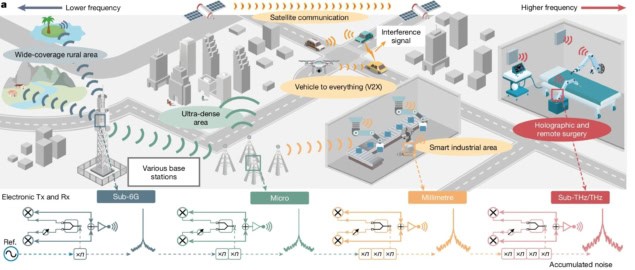
Researchers in China have unveiled an ultrabroadband system that uses the same laser and resonator to process signals at frequencies ranging from below 1 GHz up to more than 100 GHz. The system, which is based on a thin-film lithium niobate resonator developed in 2018 by members of the same team, could facilitate the spread of the so-called “Internet of things” in which huge numbers of different devices are networked together at different frequency bands to avoid interference.
Modern complementary metal oxide semiconductor (CMOS) electronic devices generally produce signals at frequencies of a few GHz. These signals are then often shifted into other frequency bands for processing and transmission. For example, sending electronic signals long distances down silicon optical fibres generally means using a frequency of around 200 THz, as silicon is transparent at the corresponding “telecoms” wavelength of 1550nm.
One of the most popular materials for performing this conversion is lithium niobate. This material has been called “the silicon of photonics” because it is highly nonlinear, allowing optical signals to be generated efficiently at a wide range of frequencies.
In integrated devices, bulk lithium niobate modulators are undesirable. However, in 2018 Cheng Wang and colleagues led by Marko Lončar of Harvard University in Massachusetts, US, developed a miniaturized, thin-film version that used an interferometric design to create a much stronger electro-optic effect in a shorter distance. “Usually, the bandwidth limit is set by the radiofrequency loss,” explains Wang, who is now at the City University of Hong Kong, China. “Being shorter means you can go to much higher frequencies.”
A broadband data transmission system
In the new work, Wang, together with researchers at Peking University in China and the University of California, Santa Barbara in the US, used an optimized version of this setup to make a broadband data transmission system. They divided the output of a telecom-wavelength oscillator into two arms. In one of these arms, optical signal modulation software imprinted a complex amplitude-phase pattern on the wave. The other arm was exposed to the data signal and a lithium niobate microring resonator. The two arms were then recombined at a photodetector, and the frequency difference between the two arms (in the GHz range) was transmitted using an antenna to a detector, where the process was reversed.
Crucially, the offset between the centre frequencies of the two arms (the frequency of the beat note at the photodetector when the two arms are recombined) is determined solely by the frequency shift imposed by the lithium niobate resonator. This can be tuned anywhere between 0.5 GHz and 115 GHz via the thermo-optic effect – essentially, incorporating a small electronic heater and using it to tune the refractive index. The signal is then encoded in modulations of the beat frequency, with additional information imprinted into the phase of the waves.
The researchers say this system is an improvement on standard electronic amplifiers because such devices usually operate in relatively narrow bands. Using them to make large jumps in frequency therefore means that signals need to be shifted multiple times. This introduces cumulative noise into the signal and is also problematic for applications such as robotic surgery, where the immediate arrival of a signal can literally be a matter of life and death.
Internet of things applications
The researchers demonstrated wireless data transfer across a distance of 1.3 m, achieving speeds of up to 100 gigabits per second. In the present setup, they used three different horn antennas to transmit microwaves of different frequencies through free space, but they hope to improve this: “That is our next goal – to get a fully frequency-tuneable link,” says Peking University’s Haowen Shu.
The researchers believe such a wideband setup could be crucial to the development of the “Internet of things” in which all sorts of different electronic devices are networked together without unwanted interference. Atmospheric transparency windows below 6 GHz, where loss is lower and propagation lengths are higher, are likely to be crucial for providing wireless Internet access to rural areas. Meanwhile, higher frequencies – with higher data rates – will probably be needed for augmented reality and remote surgery applications.

Lithium niobate photonic integrated circuits create ultrafast tunable laser
Alan Willner, an electrical engineer and optical scientist at the University of Southern California, US, who was not involved in the research, thinks the team is on the right track. “You have lots of spectrum in various radio bands for wireless communications,” he says. “But how are you going to take advantage of these bands to transmit high data rates in a cost-effective and flexible way? Are you going to use multiple different systems – one each for microwave, millimetre wave, and terahertz? Using one tuneable and reconfigurable integrated platform to cover these bands is significantly better. This research is a great step in that direction.”
The research is published in Nature.



